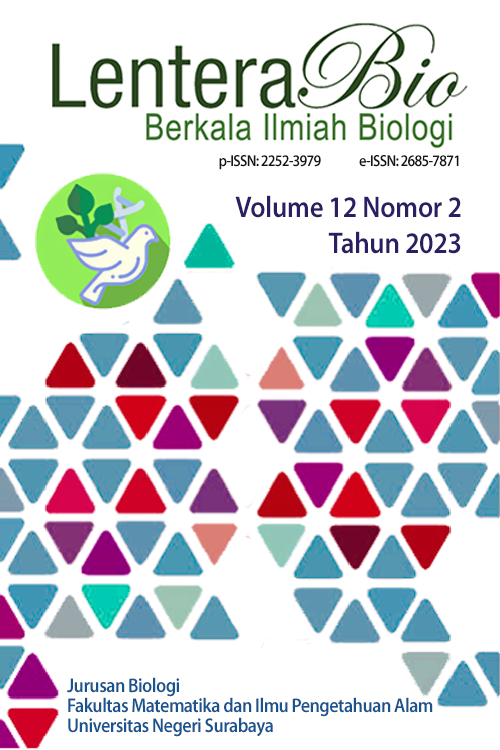Correlation between Macrozoobenthos Diversity Index and Water Quality in Surabaya River, Wringinanom, Gresik
DOI:
https://doi.org/10.26740/lenterabio.v12n2.p219-228Keywords:
Surabaya river, macrobenthos diversity index, water qualityAbstract
Kali Surabaya is river that widely used by local residents as recreational infrastructure,
freshwater fish cultivation, and farms. This study aims to identify the types of macrozoobenthos,
to analyze the macrozoobenthos diversity index, water quality in terms of physico-chemical
parameters and the relationship between macrozoobenthos diversity index and water quality in
terms of physico-chemical parameters in Kali Surabaya, Wringinanom, Gresik. This type of
research is quantitative and qualitative observational study and analyzed descriptively and
inferentially. Eight species from five families were found with the most species was Melanoides
tuberculata. The diversity index was calculated using the Shanoon-Wiener formula. Kali
Surabaya has macrozoobenthos diversity index of 1.01 which in the moderate diversity category.
The water quality of Kali Surabaya, Wringinanom, Gresik is polluted due to temperature with
an average value of 28,75°C and COD levels with an average value of 54,29 mg/l which not
accordance with quality standards. The relationship between diversity index and water quality
in terms of physico-chemical parameters showed negative correlation, namely the parameters
pH, temperature, and brightness, while positive correlations, namely DO, BOD, COD, turbidity,
depth and current speed. The DO parameter has very strong positive correlation with diversity
index of (+0.949) which indicates moderately polluted water quality.
Downloads
Published
How to Cite
Issue
Section
License
Copyright (c) 2023 LenteraBio : Berkala Ilmiah Biologi

This work is licensed under a Creative Commons Attribution-NonCommercial 4.0 International License.
Hak Cipta (c) LenteraBio: Berkala Ilmiah Biologi
Karya ini dilisensikan di bawah Lisensi Internasional Creative Commons Attribution-NonCommercial 4.0.
Pemberitahuan Hak Cipta.
Hak cipta dari artikel yang diterima untuk diterbitkan akan diberikan kepada jurnal sebagai penerbit jurnal. Hak cipta yang dimaksud meliputi hak untuk menerbitkan artikel dalam berbagai bentuk (termasuk cetak ulang). Jurnal mempertahankan hak penerbitan atas artikel yang diterbitkan.
 Abstract views: 690
,
Abstract views: 690
, PDF Downloads: 2900
PDF Downloads: 2900











